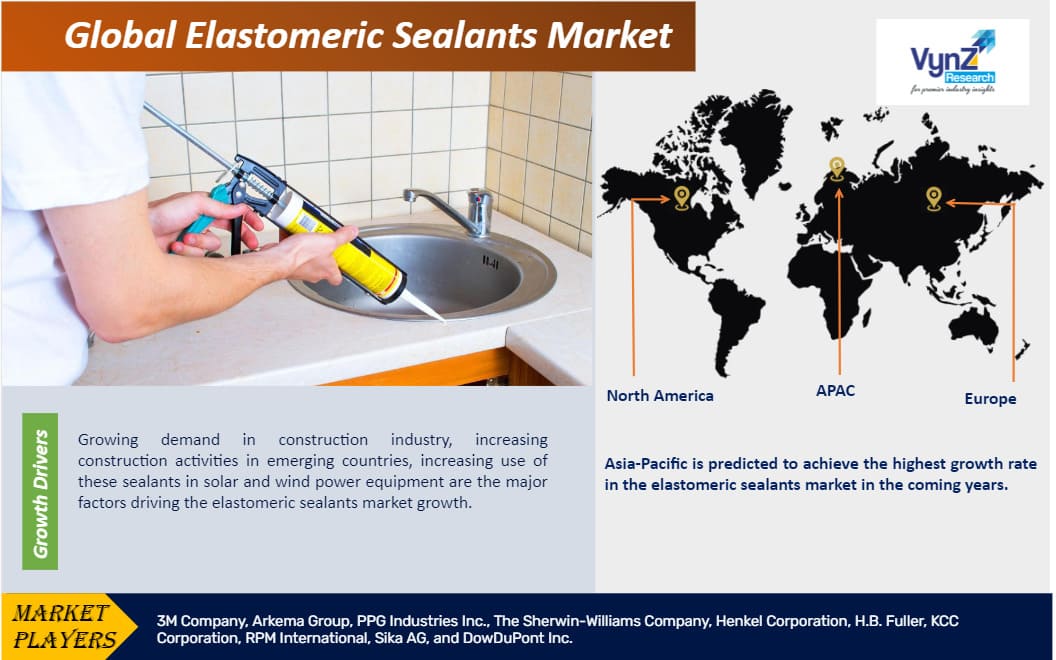Global Elastomeric Sealants Market – Analysis and Forecast (2026-2035)
Industry Insights by Type (Silicone, Polysulfide, polyurethanes, Silyl Modified Polymers, Polybutadiene), by End-User (Construction, Automotive, Electronics, Furniture & Woodwork, Aerospace & Defense, Marine) and by Geography (North America, Europe, Asia-Pacific, Middle East, and Rest of the World)
| Status : Upcoming | Report Code : VRCH2021 | Industry : Chemicals & Materials | Available Format :

|
Global Elastomeric Sealants Market – Analysis and Forecast (2026-2035)
Industry Insights by Type (Silicone, Polysulfide, polyurethanes, Silyl Modified Polymers, Polybutadiene), by End-User (Construction, Automotive, Electronics, Furniture & Woodwork, Aerospace & Defense, Marine) and by Geography (North America, Europe, Asia-Pacific, Middle East, and Rest of the World)
Industry Overview
Sealants are used to block fluids passage through the surface openings in materials. Elastomeric sealants are used for sealing, finishing, and provide surface protection, as they are elastic and flexible bonding materials. The global elastomeric sealants market is witnessing a good growth in the recent years, due to the various benefits it offers over traditional sealants. They provide good flexibility, durability, heat resistance, and adhesions that are essential in different applications such as cladding, roof building, marble works, and others. They can be used in various surfaces such as stone, steel, concrete, and other polymers.

Elastomeric Sealants Market Segmentation
Insight by Type
Based on type, the elastomeric sealants market is segmented into silicone, polysulfide, polyurethanes, silyl modified polymers, polybutadiene, and others. Of all these, silicon type category is expected to register the fastest growth in the coming years. This can be attributed to the fact that they have an advantage for weather resistance due to their inorganic chemistry. Also, the easy availability, low cost, and easy applicability is contributing towards its increasing demand. All these factors are driving its demand in the various industries including electronics, aerospace, construction, transportation, and others.
Insight by End-User
On the basis of end-user, the elastomeric sealants market is classified into construction, automotive, electronics, furniture & woodwork, aerospace & defense, marine, and others. These industries are further classified into various applications according to the use of these sealants in these end-user industries. Among all these, the construction category is expected to hold the largest share in the overall market, due to the increasing use of these sealants in different applications including parking areas, cladding, marble works, roads and highways, and others. Additionally, the increasing construction projects in emerging countries such as China and India are further fueling the elastomeric sealants market growth.
Global Elastomeric Sealants Market Report Coverage
|
Report Metric |
Details |
|
Historical Period |
2020 - 2024 |
|
Base Year Considered |
2025 |
|
Forecast Period |
2026 - 2035 |
|
Market Size in 2025 |
U.S.D. xx Billion |
|
Revenue Forecast in 2035 |
U.S.D. xx Billion |
|
Growth Rate |
xx% |
|
Segments Covered in the Report |
By Type, and By End-User |
|
Report Scope |
Market Trends, Drivers, and Restraints; Revenue Estimation and Forecast; Segmentation Analysis; Impact of COVID-19; Companies’ Strategic Developments; Market Share Analysis of Key Players; Company Profiling |
|
Regions Covered in the Report |
North America, Europe, Asia-Pacific, Middle East, and Rest of the World |
Industry Dynamics
Elastomeric Sealants Market Growth Drivers
Growing demand in construction industry, increasing construction activities in emerging countries, increasing use of these sealants in solar and wind power equipment are the major factors driving the elastomeric sealants market growth. The rising number of construction activities in the emerging countries including India, China, South Korea, and others, coupled with continuous innovations in the area of building construction in mature markets is driving the market growth in the recent years.
Elastomeric Sealants Market Challenges
A regulation related to volatile organic compounds (VOC) content in elastomeric sealants is identified as the major challenge hindering the elastomeric sealants market growth. Department of Environmental Protection has laid down a regulation related to control of VOC compounds from adhesives and sealants. This regulation limits emissions of VOC from sealants, adhesives, and primers. The restriction regarding the use is primarily applied to commercial and industrial applications.
Elastomeric Sealants Market Industry Ecosystem
The sealants market is quite fragmented, however there is no consistent industry definition defining what exactly sealant is. Hence, there is a need to achieve a consistent standard for classifying sealants from adhesives and coatings so that it can be effective in achieving growth in the market.
Recent Developments By the Key Players
Arkema, a leader in specialty materials, is producing Ethyl Acrylate exclusively from bioethanol, at its acrylic monomer facility in Carling, France. This exclusive production of bio sourced Ethyl Acrylate in Carling France will have a global significant industry impact. It sets the stage for the next generation of sustainable coating products, empowering both our downstream production and our customers in achieving their sustainable development goals and carbon reduction objectives.
KCC Corporation has acquired Momentive Performance Materials Group which is a high-performance silicones and specialty solutions company.
Elastomeric Sealants Market Geographic Overview
Globally, Asia-Pacific is predicted to achieve the highest growth rate in the elastomeric sealants market in the coming years. This is attributed to the growing application of these sealants in various end use industries. Also, due to increasing population along with shift in manufacturing units from developed countries to the region is boosting the market growth.
Elastomeric Sealants Market Competitive Insight
- 3M Company
- Arkema Group
- PPG Industries Inc.
- The Sherwin-Williams Company
- Henkel Corporation
- H.B. Fuller
- KCC Corporation
- RPM International
- Sika AG
- DowDuPont Inc
Frequently Asked Questions
Purchase Options
Latest Report
Research Methodology
- Desk Research / Pilot Interviews
- Build Market Size Model
- Research and Analysis
- Final Deliverabvle
Connect With Our Sales Team
- Toll-Free: 1 888 253 3960
- Phone: +91 9960 288 381
- Email: enquiry@vynzresearch.com
Elastomeric Sealants Market
